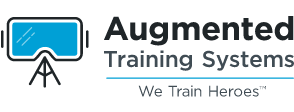Traditional training lacks variety when it comes to learning. Virtual Reality training offers the opportunity to create scenarios with more realism than ever before, which can help organizations build better, faster, and much cheaper training strategies.
Advantages of Virtual Reality
Immersiveness
Interactivity
Embodiment
Consistency
Replicability
Safety
| Traditional Training Challenges | Our VR solution |
| Live Training Occurs Infrequently | Skill mastery requires repetition and virtual reality training offers a variety of complex scenarios and missions that can be accessed remotely, anytime, and anywhere reducing the logistical challenges of training large groups of people. |
| Traditional Training Lacks Variety | Online, didactic, and traditional methods are limited. They are not engaging, lack situational awareness, or the simulation of high stress situations. VR provides realistic scenarios that can be easily changed or randomized to help professionals reach a level of confidence and proficiency. |
| Traditional and Live Training no ROI | Current education costs on average $150 a person per CEU and live training costs on average $50-100k for one event. Our Trainings can be as low as $45 per trainee a year and can be used 365 days. |
| Increased Confidence & Memory | Skill degradation following training occurs beginning at approximately 3 months, and annual training may not be enough. Switching to VR training improves cognitive and physical memory of mission-critical tasks and enhances confidence one can effectively respond when called upon. |
| Inconsistent Performance Monitoring | Our solution enables trainers to have performance analytics to ensure all team members are hitting their marks and are mission-ready. Using a cloud-based platform allows trainers to give real-time feedback to students, receive on-demand data on student progression, and have the ability to repeat training to achieve proficiency. |
Benefits of VR based training
- Reduced time and cost burden of live complex incident training
- Safely introduced stress and prevent trauma during disaster training
- Overcoming limiting logistics with immersive and repeatable VR based training
- Real-time data feedback to validate individual and team readiness
- Flexibility for team training anywhere, anytime, and with anyone
- Better training outcomes across disciplines with a modern training strategy
Evidence-based training effectiveness of Virtual Reality
- Improvement of fine-motor performance skills
- Reinforcement of mental models for the transfer of real-world tasks
- Advancement of team-building features
- Enhancement of spatial navigation abilities
- Increase in post-test evaluation scores
- Recovery of self-confidence in individual level
- Promotion of knowledge gaining
Our Results
Increased Memory Calls (↑45%)
Improved cognitive and physical memory of mission-critical tasks and up to a 45% reduction in errors.
Decreased Time On Task (↓29%)
Training resulted in up to a 29% reduction in time-on-task and a 91% acceptance rate amongcadets who participated
Increased Confidence (↑82%)
82% of Austin EMS cades felt prepared for the testing of selected topics after participating in the AR & VR training.
Decreased Cost (↓90%)
Our trainings can be implemented at a 90% reduction of the original cost of a training moulage-style training.


